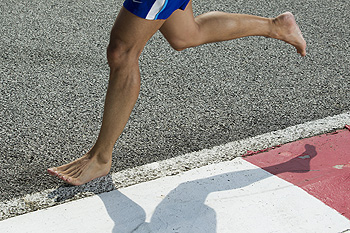 There are a number of health conditions that are affiliated with obesity. Swollen feet and varicose veins are common in obese people. Additionally, painful conditions such as cracked heels can also occur from obesity due to excessive pressure on the area. Obesity generally also contributes to diabetes, which can affect the nerves in the feet. Subsequently, patients are often unable to feel cuts or blisters, which may lead to foot ulcers. Poor balance may occur as a result of strained walking, which typically leads to falls and injury. Additionally, flat feet can develop, which may lead to conditions like plantar fasciitis. Following a healthy diet that is low in sugar may help control obesity. Maintaining a regular exercise program will aid in keeping obesity under control. Typically, obesity leads to feet that are wider than average, so look for shoes that fit properly. A podiatrist can conduct a foot examination and provide tips on obesity and how it affects the feet.
There are a number of health conditions that are affiliated with obesity. Swollen feet and varicose veins are common in obese people. Additionally, painful conditions such as cracked heels can also occur from obesity due to excessive pressure on the area. Obesity generally also contributes to diabetes, which can affect the nerves in the feet. Subsequently, patients are often unable to feel cuts or blisters, which may lead to foot ulcers. Poor balance may occur as a result of strained walking, which typically leads to falls and injury. Additionally, flat feet can develop, which may lead to conditions like plantar fasciitis. Following a healthy diet that is low in sugar may help control obesity. Maintaining a regular exercise program will aid in keeping obesity under control. Typically, obesity leads to feet that are wider than average, so look for shoes that fit properly. A podiatrist can conduct a foot examination and provide tips on obesity and how it affects the feet.
Obesity has become very problematic at this point in time and can have extremely negative effects on the feet. If you’re an obese individual and are concerned about your feet, contact one of our podiatrists from Westside Podiatry Center, LLP. Our doctors can provide the care you need to keep you pain-free and on your feet.
Obesity and Your Feet
Since your feet are what support your entire weight when standing, any additional weight can result in pain and swelling. Being overweight is one of the main contributors to foot complications.
Problems & Complications
Extra Weight – Even putting on just a few extra pounds could create serious complications for your feet. As your weight increases, your balance and body will shift, creating new stresses on your feet. This uneven weight distribution can cause pain, even while doing the simplest tasks, such as walking.
Diabetes – People who are overweight are at serious risk of developing type-2 diabetes, which has a drastic impact on the health of your feet. As you get older, your diabetes might worsen, which could lead to loss of feeling in your feet, sores, and bruises. You could also become more prone to various infections.
Plantar fasciitis – Pressure and stress that is placed on muscles, joints, and tendons can trigger plantar fasciitis, which is an inflammation of tissue that forms along the bottom of the foot.
If you have any questions please feel free to contact one of our offices located in Liverpool, Camillus, Skaneateles, Oswego, and Cicero, NY . We offer the newest diagnostic and treatment technologies for all your foot and ankle needs.


